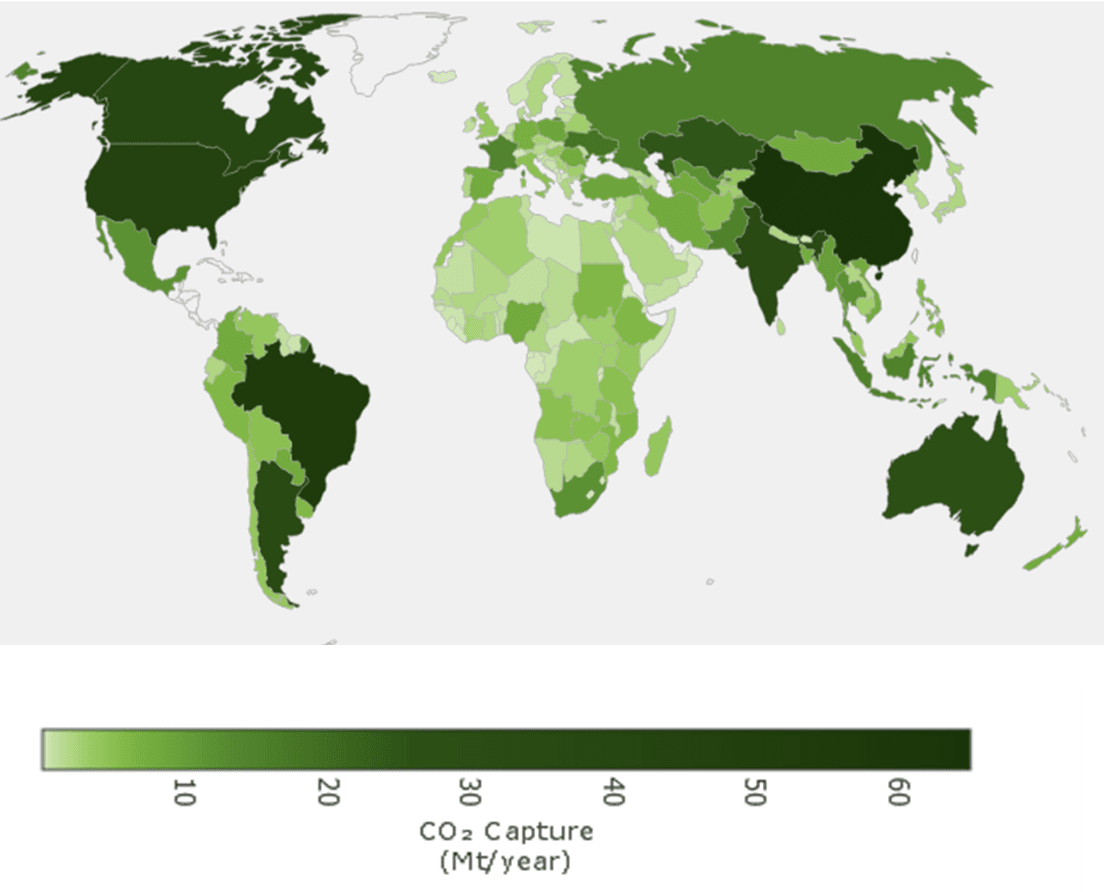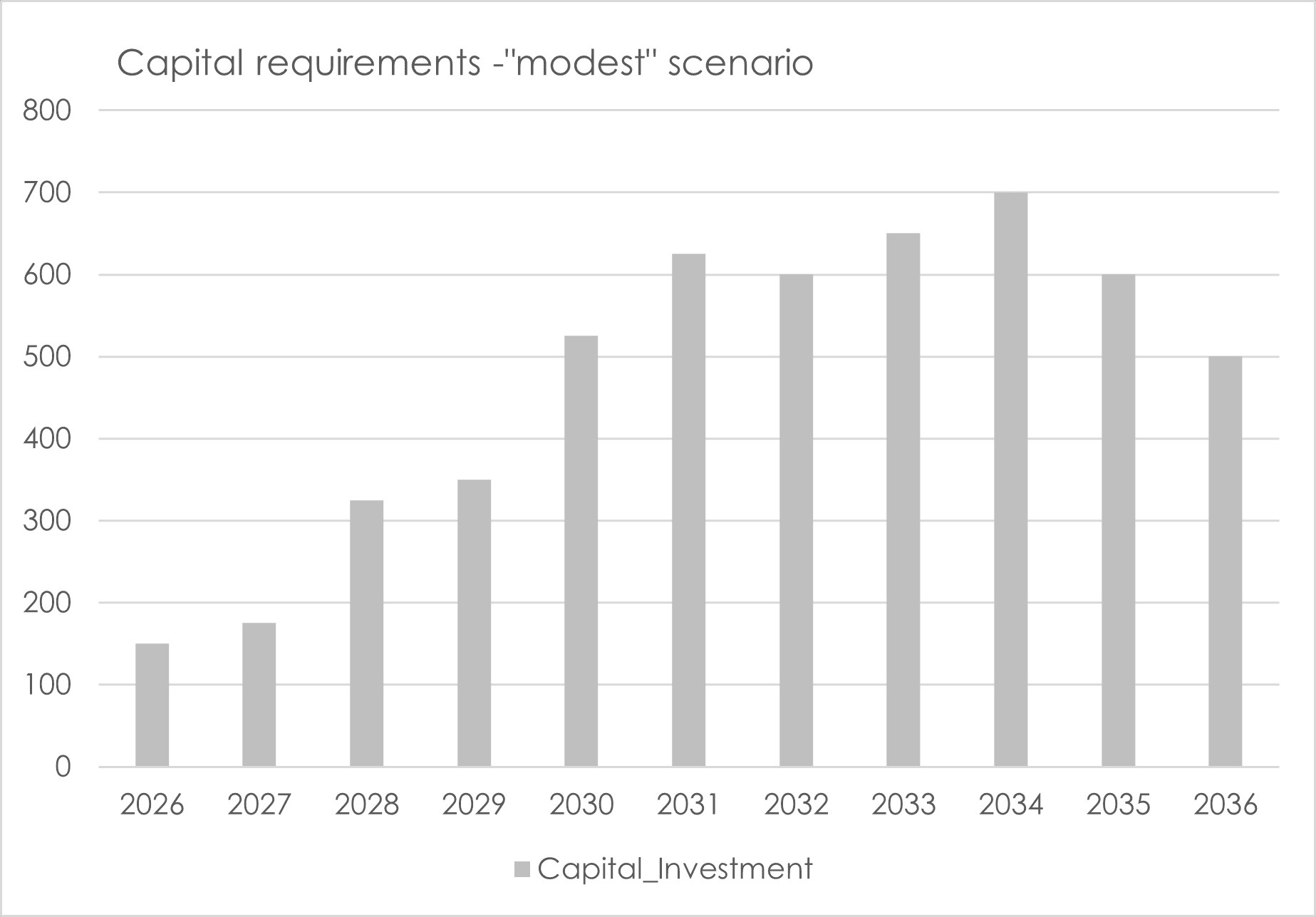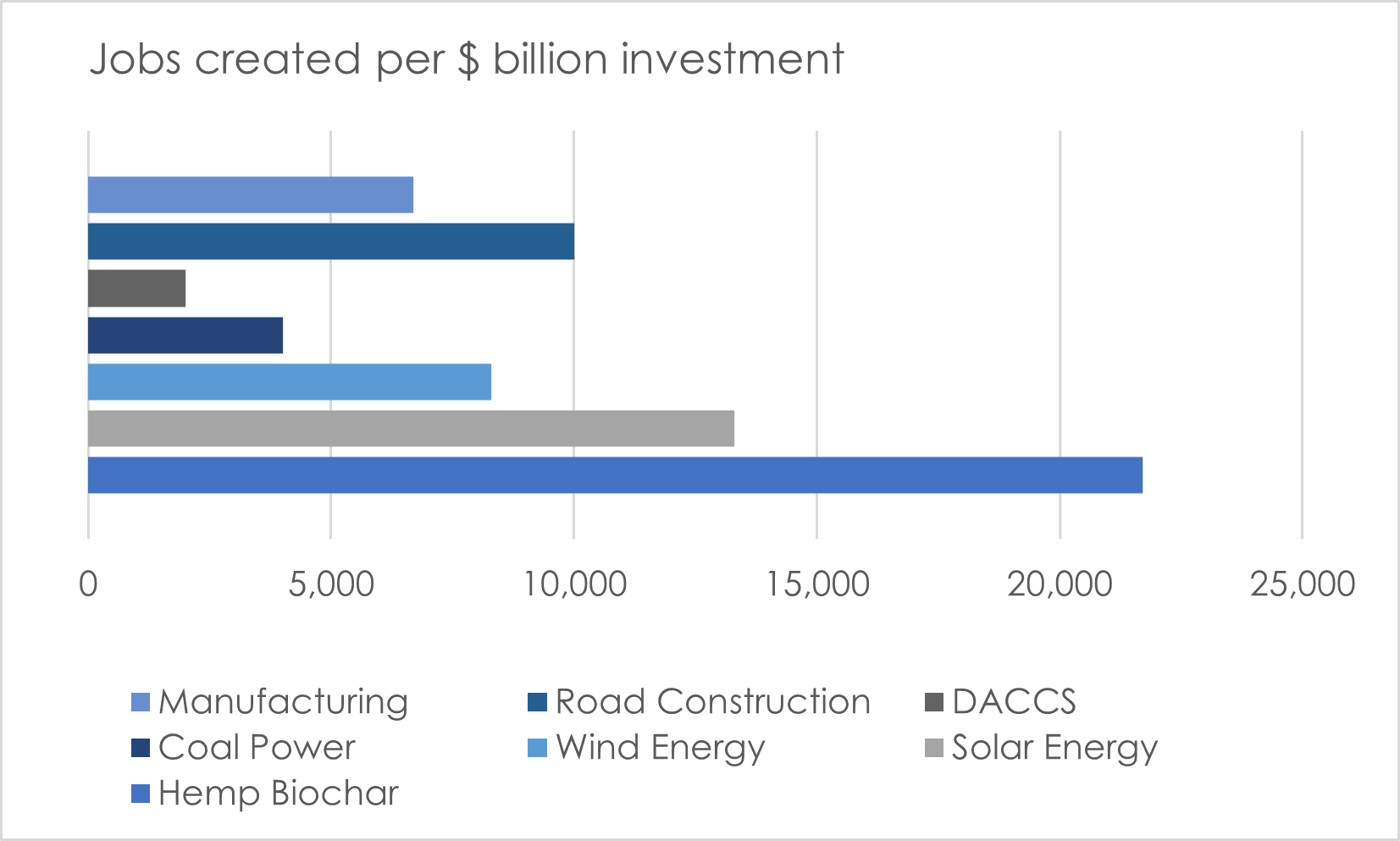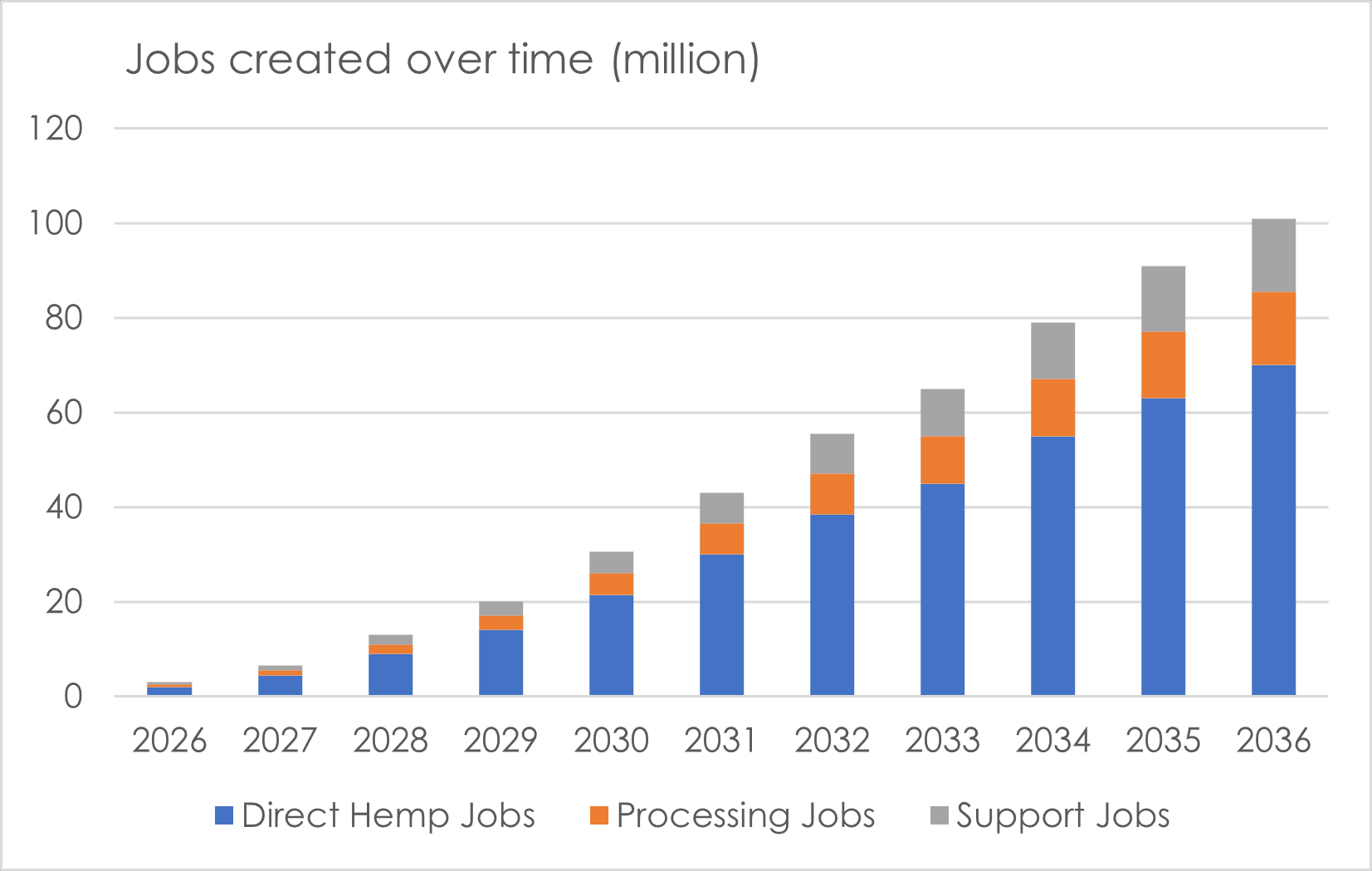Beyond Carbon
Giga-scale carbon removal with hemp biochar
Large-scale carbon removal with
hemp biochar
Creating 100 million jobs. Removing 10 gigatonnes of CO2 from the atmosphere per year (30% of 2025 global emissions). Five years pay-back.
If that sounds crazy, it is because it is not.
A new study examines whether hemp cultivation could become one of humanity’s most powerful tool for removing atmospheric CO2 – while simultaneously creating sustainable materials and economic opportunity.
We are currently seeing temperatures on a global scale that were not experienced in the last 125’000 years; CO2 concentration is higher than at any point in the last 3 million years. We urgently need to remove 10 billion tonnes of CO2 annually to limit warming to a somewhat acceptable level.
Current carbon removal technologies face severe limitations: Direct Air Capture costs $600-1,000 per tonne and requires massive energy inputs – and is, after more than 20 years of heavily subsidised research, still in its infancy. Nature-based solutions like forests take decades to mature and remain vulnerable to fire and disease.
Hemp biochar offers something different: a solution that works with today’s technology, creates permanent carbon storage, and generates revenue rather than just costs.
Hemp grows in different climates. It does not need fertiliser. It is resistant against fungi and pests. And it can grow up to 4 meters tall in 100 days. That is a lot of biomass. And biomass is carbon – CO2 sequestered from the atmosphere. If it is let to rot, then the decomposition process will release that CO2 back into the atmosphere. Unless… it doesn’t. Through pyrolysis (thermal decomposition of organic materials at high temperatures in the absence of oxygen), the organic carbon turns to charcoal, or biochar. Biochar is stable, meaning the CO2 is bound for forever.
Hemp biochar has many useful uses – as filter that catches microplastics in water, for example, or in cosmetics, but mostly in soil to increase water retention, fertility, and soil carbon absorption.
Hemp can also be used as construction material (for boards and panels, as insulation, and for bricks); it’s fibres have made clothes and ropes for centuries, and it can also be used in composite materials. These materials also keep the CO2 that has been captured by the plant.
Hemp can grow in on meadows and grazing land, even on degraded land, in almost all environmental conditions. Hemp captures – depending on growth conditions – 8 to 20 tones of CO2 per hectare and growth cycle (in favourable climate conditions, 2 harvests a year are possible).
If grown on a billion hectares – equivalent to roughly 30% of current meadows and grazing land – we could capture 10 billion tones of CO2 per year, roughly a third of global 2025 emissions. At the same time, selling hemp is a huge global business opportunity that could create a market of several trillion dollars and generate 100 million jobs – mostly in underdeveloped rural areas.
Download the full report here: Beyond Carbon: Large-Scale Carbon Removal with Hemp Biochar
Total CO2 absorption potential
CO2 removal potential with 30% of current meadows/grazing land used for Hemp cultivation, biochar and hemp product production

CO2 absorption potential by country
Hemp removal potential by country, based on geography, climate environment, and current land usage

The scale of the hemp carbon removal opportunity
This comprehensive analysis examines whether hemp cultivation could become humanity’s most powerful tool for removing atmospheric CO2 while simultaneously creating sustainable materials and economic opportunity.
Speed Advantages
- Low-tech, available now – no further research and pilot project required (unlike DACCS)
- Distributed deployment – 20’000 small plants vs 1,000 mega-facilities
- Existing supply chains – agricultural equipment is available
- Simple permitting – agricultural vs industrial regulation
- Immediate sequestration – sequestration starts in year one, no 20-year forest growth
Cost Advantages
- 10x cheaper than DACCS ($45 vs $600/tCO2)
- 3x cheaper than BECCS ($45 vs $150/tCO2)
- Costs decrease with scale (learning curve benefits)
- Co-products offset costs (even with price collapse)
- Low energy requirements (feasible with current grid
Scale Advantages
- Can achieve 10 Gt/yr in short time – the only technology capable of achieving meaningful carbon removal by 2035
- 1 billion hectares available (30% of land currently used for meadows and grazing)- sufficient suitable land exist
Linear scaling – no technical barriers to expansion
- Geographic distribution – every region can participate & contribute
- 100 million jobs created – addressing both social and climate crisis
Investment Required:
$4.8 trillion over 10 years – but with high returns and pay-back estimated to be between 2.6 and 11 years (5 years high confidence). Such an investment would be equivalent to:
- Equal to 2.4 years of global military spending
- Less than 1/3 of COVID economic response
- A fraction of projected climate damage
Beyond Carbon: An Economic Revolution
The true potential of hemp lies not in single-product thinking but in integrated value creation. From one hectare of hemp, we can produce:
- 3-4 tonnes of biochar for permanent carbon sequestration and soil improvement
- 2.5-3.5 tonnes of fiber for textiles and composite materials worth $800-2,000 per tonne
- 3.5-5 tonnes of hurds for construction materials and insulation worth $200-500 per tonne
- Bio-oil and syngas from the pyrolysis process for energy generation
This diversification transforms carbon removal from a cost centre into a profitable enterprise. Our analysis shows that even with inevitable price erosion as markets scale, farmers could earn $450-750 per hectare in net profit while sequestering 8-12 tonnes of CO2 permanently.
Download the full report here: Beyond Carbon: Large-Scale Carbon Removal with Hemp Biochar
Capital investment requirements

Total global investments required to scale global hemp production to one billion hectares (10 billion tons of CO2 absorbed annually).
Costs, revenues and net-cash flow

Capital requirements, operational cost, expected revenues and net profitability of a potential large-scale hemp deployment. Pay-back or break-even point could be reached as early as in 3 years under favourable conditions, 11 years under worst case scenario.
Jobs and Social Impact
Hemp biochar would create 100-150 million jobs globally (taking into account job replacement in agriculture, construction material and textile industries) – one of the largest job creation programs in history. These jobs would primarily benefit rural communities in developing countries where employment is most desperately needed.
Download the full report here: Beyond Carbon: Large-Scale Carbon Removal with Hemp Biochar
Job creation by carbon capture methodology

Job created from hemp deployment

Why Hemp Biochar Beats the Alternatives
Compared to other carbon removal technologies, hemp biochar offers unique advantages:
| Technology | Cost per tonne CO2 | Maximum scale | Energy needed | Time to deploy |
|---|---|---|---|---|
| Hemp Biochar | $45-60 | 10+ Gt/year | 0.5 MWh | 2-3 years |
| Direct Air Capture | $600-1,000 | 0.5-1 Gt/year | 8-12 MWh | 5-7 years |
| Enhanced Weathering | $50-200 | 2-4 Gt/year | 1-2 MWh | 10+ years |
| Afforestation | $20-50 | 3-4 Gt/year | None | 20+ years |
Only hemp biochar combines the scale, speed, permanence, and economics needed for emergency climate response.
The Science is Solid
Hemp’s carbon sequestration potential isn’t theoretical. High-temperature pyrolysis produces biochar with millennial-scale stability. Studies of ancient Amazonian terra preta soils show biochar persisting for thousands of years. Modern research confirms that biochar produced above 600°C remains stable for 1,000-10,000+ years – as permanent as geological CO2 storage but without the infrastructure.
Multiple peer-reviewed studies document hemp’s biomass production of 8-20 tonnes per hectare, with CO2 capture rates of 9-22 tonnes per hectare during the growing season. When converted to biochar, 5-10 tonnes of CO2 per hectare can be permanently sequestered, with the remainder used in products that store carbon for decades to centuries.
Challenges and Risks
This analysis doesn’t ignore the significant challenges:
- Market saturation is certain – biochar prices will likely fall from $200 to $40 per tonne, as will carbon credit prices and other hemp-based products
- Execution complexity at billion-hectare scale requires unprecedented coordination
- Political resistance from competing interests must be overcome
- Infrastructure development needs $500 billion for processing facilities alone
Yet our sensitivity analysis shows the project remains viable even with 30% adverse movement in all major variables. The diversified product strategy provides natural hedging against single market risks.
If not Closed yet, the Window is Closing Fast
Every year of delay means 37 billion tonnes more CO2 in the atmosphere and higher future removal costs. The technology exists today. The land is available. The economics work even with conservative assumptions.
What we lack is not means but mobilisation.
Hemp biochar represents more than a climate solution – it’s an opportunity to demonstrate that environmental restoration and economic development can align. By creating value from carbon removal, generating employment for millions, and producing sustainable materials for the growing bio-economy, this approach offers a pathway to both climate stability and shared prosperity.
Read the Full Report
The comprehensive analysis that follows examines every aspect of this opportunity:
- Detailed regional deployment strategies
- Technology specifications and infrastructure requirements
- Financial models under multiple scenarios
- Risk assessment and mitigation strategies
- Policy frameworks needed for success
- Comparison with all alternative technologies
The data is clear: hemp biochar at billion-hectare scale is not just possible – it’s our best available option for achieving the gigaton-scale carbon removal essential for climate stability. The question is not whether we can do it, but whether we will act with the speed and scale our planet requires.
The solution is ready. The time is now.
Read the full report here: Beyond Carbon: Large-Scale Carbon Removal with Hemp Biochar


